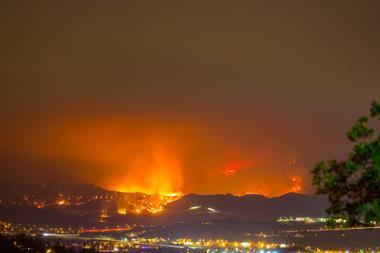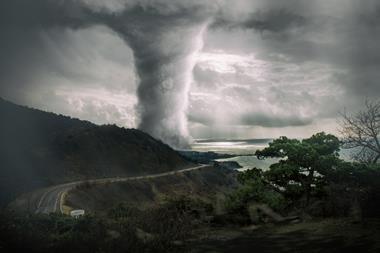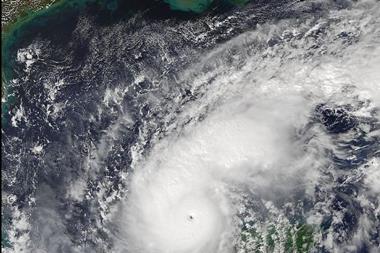Despite the comic book scale of catastrophe in the film, the potential for more extreme events in response to global warming does have some roots in hard science. For a number of years, scientific studies and assessments have been hinting at the potential for greater climate variability and, subsequently, extreme weather events. Substantial reinforcement of this perception has been provided by the media, which is quick to report on severe weather and increasingly interested in its relationship with global warming.
This fascination with extreme weather events and global warming is understandable.
In the United States alone, disasters associated with weather inflict considerable economic costs averaging $23 billion per year, not to mention over 1,500 deaths (Table 1). Interestingly, temperature extremes, which would appear most directly relevant to global warming, cause negligible property damage, but are the leading cause of death. In contrast, the most violent extremes (e.g., hurricanes and tornadoes), cause catastrophic economic losses, but relatively few deaths in the developed world.
Annual averages mask considerable year-to-year variability associated with extreme weather events and their societal impact. For example, an average of 1.6 hurricanes strike the US coastline every year. In 2004, however, an active hurricane season resulted in four hurricane strikes and $56 billion in total economic losses, with $27 billion in insured losses, according to Swiss Re. When one considers that about 25% of the US economy is comprised of sectors that are sensitive to weather and climate, such as agriculture and tourism, any potential increase in the frequency or intensity of severe weather would have substantial implications. Yet, unraveling and clarifying the complex connection among global warming, extreme events and society is a challenging task.
Historical trends
Over the 20th century, average annual temperatures in the United States increased by approximately O.56 deg C (1 deg F) and precipitation increased by 5-10%. These seemingly small changes have been accompanied by an apparent epidemic of climate catastrophes in recent decades. In 1992, Hurricane Andrew caused $35 billion in economic damages and 40 deaths. Atlantic hurricane activity, particularly the occurrence of large hurricanes (category 3 and above), has been above average since 1995. Similarly, 1998, 2003 and 2004 were record years for tornadoes as well. The 1993 flooding in the Midwest, caused approximately $15 billion in damages and 50 deaths.
Chicago's heat wave during the summer of 1997 resulted in over 700 excess deaths.
Many have been quick to link such disasters with global warming, but these events must be placed in their long term context. The 2004 US hurricane season was undoubtedly unusual in its ferocity, yet since 1851 there have been 11 years with four or more hurricane landfalls. The record year was 1886, well before the human influence on the global climate began to appear.
The active hurricane seasons in recent years appear to be attributable in large part to a cyclical pattern of climate variability known as the North Atlantic Oscillation (NAO). The 1940s-1960s also saw a period of elevated hurricane activity, which was followed by almost three decades of relative calm. Somewhere during the mid-1990s, the NAO flip-flopped once again and that period of calm came to an abrupt end.
Other indicators yield inconsistent trends with respect to long term change in extreme events. US temperature data indicate a decrease in low temperature extremes (e.g. frost days) over the 20th century, but also a decrease in high temperature extremes. US drought statistics show no long term trend, although the record is dominated by the Dust Bowl era mega-droughts of the 1930s-40s. Some evidence suggests that the observed increase in US precipitation has manifested itself largely as severe rainfall events. In any case, identifying a coherent signal of increasing frequency or severity in weather extremes amid the noise of natural variability is a challenging task. One should be quite cautious about attributing cause to any individual event or making assumptions about the likelihood of future events from observed data.
Climatology v. sociology
Although climate data portray a somewhat ambiguous picture of changes in climate extremes, economic data show a clear trend toward greater losses from severe weather. During the latter half of the 20th century, the average annual number of storms causing over $5 million in insured losses increased three-fold and federal relief payments for severe weather events increased by a factor of six. The principal driver of this trend, however, has been changes in the structure of society and the economy, rather than global warming. Over the 20th century, the US population increased from 76 million to over 270 million, and GDP increased over 100-fold. The impact of severe weather has grown accordingly, due to the exposure of more people, property and wealth. After decades of migration, 54% of the US population now lives in close proximity to the coast, a trend mirrored in other regions of the world such as the mega-cities of southeast Asia. These socio-economic changes have been the principal, long term driver of economic damages from severe weather.
Socio-economic factors are also important in determining the range and effectiveness of risk management strategies. The United States has invested heavily in storm forecasting and early warning systems, coastal planning and disaster management. As a consequence, while economic damages from hurricanes have steadily risen over time, mortality from such events has declined. The 1900 Galveston, Texas, hurricane claimed 6,000-8,000 lives, according to US government figures, a loss of life up to 200 times that associated with Hurricane Andrew a century later.
The benefits of risk management extend beyond the saving of lives. Risk assessment and early warning systems create the opportunity to place property and activities in low risk areas or move property out of harm's way. Meanwhile, city planning, building codes and zoning laws, and compulsory insurance have also reduced the exposure and vulnerability of communities to extreme weather and helped spread risk. The availability and implementation of such risk management practices is a direct function of economic growth and development, access to knowledge and technology and experience. The rapidly rising economic toll of severe weather, however, suggests that growth in the development and implementation of risk management practices has not kept pace with the growth in society's exposure. As a consequence, the capacity of even wealthy nations to cope with catastrophes is becoming increasingly strained.
The outlook for climate risk
The United Nations has estimated that the economic burden of global warming could be on the order of $300 billion by 2050, some proportion of which would be born by the insurance industry. Such figures do not address specific issues related to extreme events and/or catastrophic losses. Generally, assessments of future warming damages increase after climate variability and extremes are incorporated. The estimated damages in Table 1 suggest that even a small percentage increase in the frequency or severity of extreme events would have substantial economic consequences.
With respect to hurricanes, the long term, natural oscillation in the Atlantic climate will likely result in a higher risk of larger Atlantic hurricanes for the next few decades. Recent studies have suggested that global warming could increase average hurricanes wind speeds by approximately 5% - a seemingly small increase, but damages from hurricanes increase exponentially with wind speed. However, there is little evidence to suggest that the number of hurricanes forming in the Atlantic will increase. In addition, studies have indicated that higher temperatures will contribute to higher summer heat indices and shorter return periods for heat waves.
Increased aridity will likely translate into greater risk of wildfires in some regions. Meanwhile, global increases in precipitation, particularly extreme rainfall events, would have obvious implications for flooding.
The nature and severity of such events will vary considerably among regions, but the ability of scientists to project changes in many types of severe weather, such as wind and hail storms, is quite limited and reliable, long term forecasts cannot be provided.
Such changes in extremes have the potential to increase damages at the margins. Yet, the major driver of the future economic and public health consequences of severe weather will continue to be the socio-economic factors that control the exposure of people and property to extreme events.
The city of New Orleans, for example lies 1.5-3.0 meters (5-10 feet) below sea level, making it one of the most vulnerable areas in the United States to hurricanes. The city's flood defenses are built to withstand a category 3 hurricane. Global warming will raise sea levels and may cause a slight increase in the probability that a future hurricane steering toward the city exceeds the category 3 threshold. But the primary risk factors are New Orleans' geographic and geologic position, its population size and density, the value of associated property and future decisions regarding the management of risk.
The demand for risk management strategies and services will undoubtedly grow with society's exposure to extreme events. Data from the Munich Re, indicate that the relative increase in insured losses over the past several decades has been larger than that of total losses or economic growth.
Thus, the burden carried by risk spreading institutions is growing disproportionately with overall losses. The phenomenon poses current and future challenges to the insurance industry. It is no coincidence that the reinsurers Munich Re and Swiss Re are some of the leading voices calling for greater awareness and assessment of the risks posed by a changing climate. (Re)insurers are looking with greater scrutiny at the risk of extreme events, whether insurance costs reflect that risk and whether the cost of insuring some areas or activities will at some point become prohibitive.
Regardless of the uncertainty associated with global warming and extreme weather events, the issue of global warming has raised awareness regarding the vulnerability of society to the climate system in general. Yet, to insulate better the public and the economy from climate extremes, this awareness must ultimately translate into improved management, not only for the effects of future warming, but also existing climate variability. Yet, such adaptation will likely be quite uneven, given global heterogeneity in wealth, infrastructure and access to resources.
Further, minimising future economic losses - total and insured - is a more difficult challenge, which depends upon the extent to which individuals, business and communities become more strategic and proactive in managing risk.
Source: Chris Landsea. The Atlantic Hurricane Database Re-analysis Project - Results for 1851 to 1910 and 1992 Hurricane Andrew.
CSU/CIRA 2 April 2004
Dr Benjamin Preston was a senior research fellow with the Pew Center on Global Climate Change when he wrote this article. He is now working with the government of Australia. Web site: www.pewclimate.org


















